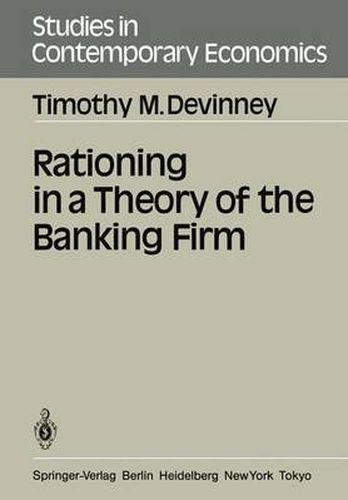Readings Newsletter
Become a Readings Member to make your shopping experience even easier.
Sign in or sign up for free!
You’re not far away from qualifying for FREE standard shipping within Australia
You’ve qualified for FREE standard shipping within Australia
The cart is loading…






This title is printed to order. This book may have been self-published. If so, we cannot guarantee the quality of the content. In the main most books will have gone through the editing process however some may not. We therefore suggest that you be aware of this before ordering this book. If in doubt check either the author or publisher’s details as we are unable to accept any returns unless they are faulty. Please contact us if you have any questions.
The existence of non-price rationing in credit markets is a subj ect, not only of paramount importance, but of considerable controversy, which is ultimately linked with our understanding, or lack thereof, of the basic nature of the banking firm. A recognition of this phenomenon is critical to the understanding of the banking firm in its major role as a financial intermediary. The banking firm serves as an intermediary in two important spheres, between borrower and lender, and between spenders and the monetary authorities. The basic economic formulation of borrower-lender behavior, the simple Fisherian consumption loan model, while beautiful in its simplicity, fail s to acknowledge any role for a non-neutral financial intermediary. The bank, in its second intermediary role, leads one to question the assumption of both neoclassical and Keynsian monetary theories that monetary changes are diffused across the economy (the proverbial monetary helicopter). Monetary policy effects on spending and investment will clearly be biased by the policies of the banks. The major focus of the present work is the development of a theory of credit rationing based upon the existence of risk reducing information technologies. Implicit in the analysis is a discussion of the role of the banking firm as something more than a tr*aditional financial intermediary. The present analysis will focus on the bank as an intermediary between borrower and lender. It will be shown that in .
$9.00 standard shipping within Australia
FREE standard shipping within Australia for orders over $100.00
Express & International shipping calculated at checkout
Stock availability can be subject to change without notice. We recommend calling the shop or contacting our online team to check availability of low stock items. Please see our Shopping Online page for more details.
This title is printed to order. This book may have been self-published. If so, we cannot guarantee the quality of the content. In the main most books will have gone through the editing process however some may not. We therefore suggest that you be aware of this before ordering this book. If in doubt check either the author or publisher’s details as we are unable to accept any returns unless they are faulty. Please contact us if you have any questions.
The existence of non-price rationing in credit markets is a subj ect, not only of paramount importance, but of considerable controversy, which is ultimately linked with our understanding, or lack thereof, of the basic nature of the banking firm. A recognition of this phenomenon is critical to the understanding of the banking firm in its major role as a financial intermediary. The banking firm serves as an intermediary in two important spheres, between borrower and lender, and between spenders and the monetary authorities. The basic economic formulation of borrower-lender behavior, the simple Fisherian consumption loan model, while beautiful in its simplicity, fail s to acknowledge any role for a non-neutral financial intermediary. The bank, in its second intermediary role, leads one to question the assumption of both neoclassical and Keynsian monetary theories that monetary changes are diffused across the economy (the proverbial monetary helicopter). Monetary policy effects on spending and investment will clearly be biased by the policies of the banks. The major focus of the present work is the development of a theory of credit rationing based upon the existence of risk reducing information technologies. Implicit in the analysis is a discussion of the role of the banking firm as something more than a tr*aditional financial intermediary. The present analysis will focus on the bank as an intermediary between borrower and lender. It will be shown that in .